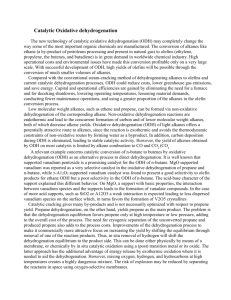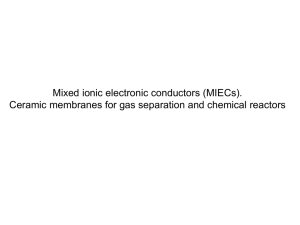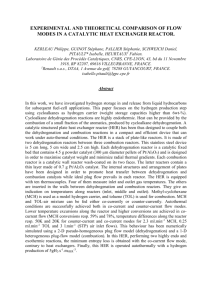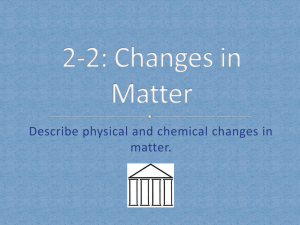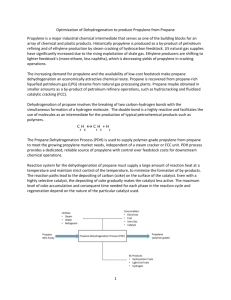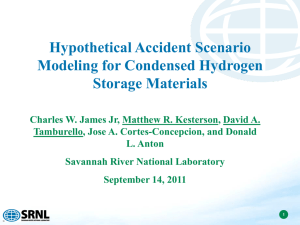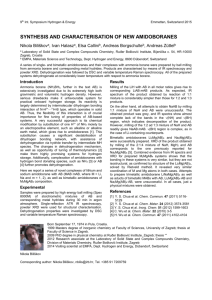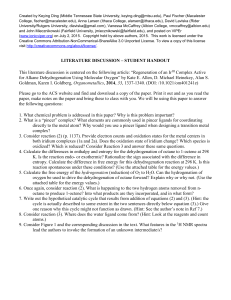Paper_281011_OO_RS_EK
advertisement
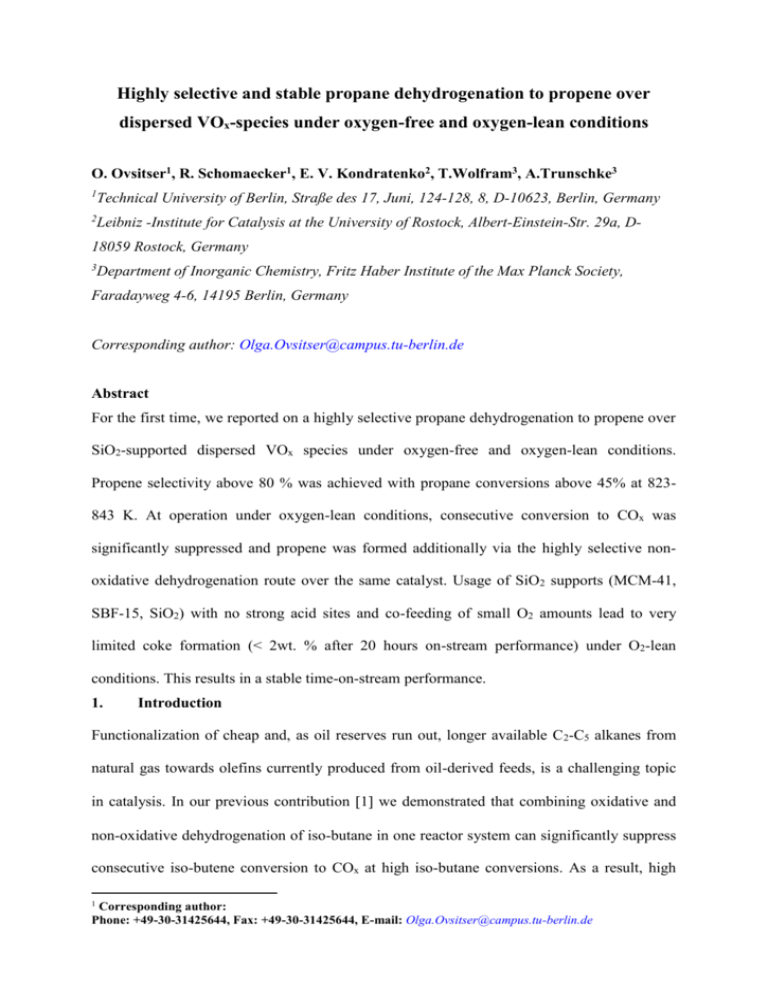
Highly selective and stable propane dehydrogenation to propene over dispersed VOx-species under oxygen-free and oxygen-lean conditions O. Ovsitser1, R. Schomaecker1, E. V. Kondratenko2, T.Wolfram3, A.Trunschke3 1 Technical University of Berlin, Straße des 17, Juni, 124-128, 8, D-10623, Berlin, Germany 2 Leibniz -Institute for Catalysis at the University of Rostock, Albert-Einstein-Str. 29a, D- 18059 Rostock, Germany 3 Department of Inorganic Chemistry, Fritz Haber Institute of the Max Planck Society, Faradayweg 4-6, 14195 Berlin, Germany Corresponding author: Olga.Ovsitser@campus.tu-berlin.de Abstract For the first time, we reported on a highly selective propane dehydrogenation to propene over SiO2-supported dispersed VOx species under oxygen-free and oxygen-lean conditions. Propene selectivity above 80 % was achieved with propane conversions above 45% at 823843 K. At operation under oxygen-lean conditions, consecutive conversion to COx was significantly suppressed and propene was formed additionally via the highly selective nonoxidative dehydrogenation route over the same catalyst. Usage of SiO2 supports (MCM-41, SBF-15, SiO2) with no strong acid sites and co-feeding of small O2 amounts lead to very limited coke formation (< 2wt. % after 20 hours on-stream performance) under O2-lean conditions. This results in a stable time-on-stream performance. 1. Introduction Functionalization of cheap and, as oil reserves run out, longer available C2-C5 alkanes from natural gas towards olefins currently produced from oil-derived feeds, is a challenging topic in catalysis. In our previous contribution 1 we demonstrated that combining oxidative and non-oxidative dehydrogenation of iso-butane in one reactor system can significantly suppress consecutive iso-butene conversion to COx at high iso-butane conversions. As a result, high Corresponding author: Phone: +49-30-31425644, Fax: +49-30-31425644, E-mail: Olga.Ovsitser@campus.tu-berlin.de 1 iso-butene selectivity and yields were obtained. In the present contribution we elaborated this approach further and applied it for propane dehydrogenation to propene. Supported catalysts with well-defined surface VOx species were used as catalysts. 2. Experimental Highly-dispersed surface VOx species were prepared by impregnating differently structured pure silica supports (MCM-41, SBF-15, SiO2) and MCM-41 modified with TiO2 with a solution of vanadium acetylacetonate in toluene. Comments of preparation of VOx(4)/SBF-15 can be added here. The vanadium content and Ti/Si molar ratio were varied from 1 to11 wt.% and from 0 to 1.5, respectively. Details of catalysts preparation and their thorough characterization (TEM, TPR, in situ UV/Vis, in situ Raman) have been reported previously 2-4 (4-reference on VOx(4)/SBF-15 preparation and characterization). The presence of only highly dispersed VOx species (no three-dimensional VOx-aggregates) was proven for the sample, having up to 5 wt.% of V. The samples are denoted here by their amount of vanadium loading (e.g. sample with V loading of 5.3 wt%, designated as VOx(5)/MCM-41). Catalytic tests were performed with low (0-0.1) O2/C3H8 ratios and contact times (W/F) of 0.003-18 g s ml-1 at temperatures of 773 - 843 K in a fixed-bed quartz reactor at atmospheric pressure, using 0.005 - 0.6 g of catalyst. The feed components and the reaction products were analysed by an on-line GC (HP 5890-II) using a Poraplot Q column and a Molsieve 5 column; Ar was used as carrier gas for GC analysis of H2. Results and Discussion Propane dehydrogenation under oxygen-free and oxygen-lean conditions Operation under the oxygen-lean or oxygen-free conditions described in this paper results in highly selective propane dehydrogenation. The propene selectivity was above 90% at a propane conversion of up to 30 % (Fig. 1). The main side products were CH4, C2H4 and C2H6. However, their individual selectivity did not exceed 5 % even at a propane conversion of approximately 50 %. Selectivity with respect to COx (mainly CO) depends on O2 partial pressure. The selectivity can be kept below 5 % by operating with C3H8/O2 ratios higher than 10. Tiny amounts of COx were also formed during the first 1-2 hours of operation under oxygen-free conditions due to the participation of oxygen of VOx–species in over-oxidising hydrocarbons. In comparison to oxidative dehydrogenation under stoichiometric conditions (Fig.2, a), the dehydrogenation of propane under oxygen-lean conditions (Fig.2, c) is significantly more selective to propene, and results in a propene yield of up to 40 % at 823-843 K. In our previous contribution 5 we did not observed significant difference in propene selectivity in oxidative propane dehydrogenation for highly dispersed VOx clusters supported over Sisupports with different morphology (SiO2, MCM-41, and MCM-48). The same is valid for vanadia supported over SBF-15 (Fig.2, a). Propene selectivity obtained over VOx(5)/MCM41 and VOx(4)/SBF-15 was very similar at comparable degree of propane conversion under oxidative dehydrogenation under stoichiometric conditions (Fig.2, a) and the dehydrogenation of propane under oxygen-lean conditions (Fig.2, c). The differences between previously reported iso-butane dehydrogenation 1 and propane dehydrogenation under oxygen-lean conditions are the following: 1) due to a stronger C-H bond in the propane molecule in comparison with that in the iso-butane molecule, 3-4 times longer contact time is required to achieve a comparable degree of alkane conversion at similar temperatures 2) thermodynamic limitation of propane dehydrogenation 7 results in a lower maximal yield of propene at a given T and alkane concentration 3) propane dehydrogenation is more selective than iso-butane dehydrogenation, in the later case selectivity to side nbutenes reach 15 % at iso-C4H10 conversion above above 50%. Because non-oxidative dehydrogenation is significantly slower than oxidative dehydrogenation (it will be discussed in the next chapter), a significantly longer contact time (>0.1 s) and slightly higher temperature (T=823-843 K) should be applied to get a significant contribution of non-oxidative dehydrogenation. However, longer contact times and higher temperatures are not sufficient to achieve a very high propene selectivity. If reaction is performed with a stoichiometic inlet ratio of C3H8/O2 =2 (Fig.2, b), the selectivity to propene will never be higher than 70%, and COx selectivity will be around 30%. The difference between areas b) and c) in the Fig.2. is the O2 content. To get a really selective performance in propane dehydrogenation (the same is valid also for iso-butane dehydrogenation) the reaction should be performed under oxygen-lean conditions, alkane/O2>10. However, we should emphasize that it is not dependence of selectivity on oxygen content within one reaction mechanism. With variation of oxygen content the contributions of different reaction pathways of propene formation, namely non-oxidative and oxidative, are varied. One more aspect should be commented on at this point. To get a significant contribution of non-oxidative dehydrogenation, the contact time was increased considerably, by 10-20 times the original. However, this increased contact time is still in the range of 2-5 seconds. Supported VOx-aggregates are very active in oxidative dehydrogenation, even when they are supported on pure SiO2 -supports and an alkane with a relatively strong C-H bond (propane) is converted. At T =773 K, over supported VOx-aggregates, a high degree of alkane conversion could be achieved with a contact time of less than 1 second via the oxidative dehydrogenation route at sufficient O2 content. However, the best results in “oxidative dehydrogenation” of propane and iso-butane were obtained in the literature mostly at a contact time of higher than 2 seconds and temperatures of T =823-873 K 12, 13. This is in area b) of Fig.2, where we started also from the stoichiometric ratio of C 3H8/O2=2; however, in this area a significant contribution of non-oxidative dehydrogenation takes place, and formation of H2 was detected. To get a significant contribution of non-oxidative dehydrogenation we need to apply longer contact times (2-5 seconds) and slightly higher temperatures (823-843 K). At such conditions the contribution of gas-phase non-catalytic dehydrogenation is possible. However, these gasphase reactions greatly depend on the free volume in a hot zone of the reactor. All our experiments were performed with a minimized volume in a hot zone of reactor and we tested the propane dehydrogenation over fused SiO2 at 833 K and a contact time of 5 g s ml-1. The degree of propane conversion did not exceed 0.3 % without the catalyst. Thus, the contribution of non-catalytic gas-phase propane conversion is negligible under the conditions applied, and propene is formed catalytically and very selectively under these conditions. Propane dehydrogenation under oxygen-lean conditions can be presented as following. In the front part of the reactor mainly oxidative propane dehydrogenation takes place with formation of propene, water and carbon oxides (Schema 1). Most of the VO x species are in the highest oxidation state 5+. At the reactor outlet predominantly non-oxidative dehydrogenation with the formation of propene and hydrogen occurs. The reduction degree of VOx species strongly increases along the catalyst bed. As a result, alkane dehydrogenation occurs via different reaction mechanisms in different zones of the catalyst bed. We would like to emphasize that such a combination of ODH and DH proceeds not simply by superposition of two processes. The catalytic process is complex with a series of competing reactions occurring simultaneously including carbon deposition resulting in catalyst deactivation. Moreover, this catalyst deactivation is very likely to proceed with different rates in various reactor zones due to various reduction degrees of VOx species, different partial pressures of oxygen and reaction products. Catalyst deactivation under oxygen-lean conditions One of the main disadvantages of non-oxidative dehydrogenation in comparison to oxidative dehydrogenation is a fast catalyst deactivation under oxygen-free conditions. VOx-supported catalysts are already reported in the literature for non-oxidative dehydrogenation. However, to our knowledge, no stable performance in alkane dehydrogenation has been reported so far. Thus, in non-oxidative butane dehydrogenation over VOx/Al2O3 catalysts 8-11 under comparable conditions already after 30 min of operation 7-8-wt. % of carbon deposits were detected. Fig. 3 shows the propene yield obtained over the VOx(5)/MCM-41 catalysts (black circles) over 20 h on-stream. The VOx(5)/MCM-41 material with highly dispersed VOx-species shows stable time-on-stream performance. Such stable operation is due to the very low formation of carbon deposits on the catalyst surface. The amount of carbon deposits formed over the catalyst after 20 hours on-stream was only 0.8 wt.% of the catalyst mass, as was determined by TPO (temperature-programmed oxidations). The amount of carbon deposits correlates with the amount of propene produced. The maximum on the TPO profile for MCM-41- and SiO2based catalysts with highly dispersed VOx-species was below 723 K, i.e. lower than the reaction temperature. Coke formation increases with increase in Ti content in the support (for Ti/Si=0.2 ca. 1 wt.% of C, and for Ti/Si=1.5-2 wt.% of C is detected after 20 hours onstream), resulting in less stable performance of VOx/SiO2-TiO2 catalysts (Fig. 3, grey triangles). It is important that such higher coke depositions are obtained over Ti-containing samples under the same reaction conditions (temperature, propane concentration, contact time) and even at lower total amount of propene produced (Fig.3). As evidenced from TPO tests with used catalysts, another carbon-containing species are formed over the VOx/SiO2- TiO2 catalyst containing the highest titania (Ti/Si=1.5) amount. These species start to be oxidized at a ca. 50 K higher temperature. We conclude therefore, that Ti increases the total amount of carbon deposition under oxygen-lean conditions and the amount of strongly bonded carbon deposits. As a result, the time-on-stream performance is less stable (Fig. 3). The stable time-on-stream performance achieved over VOx-supported on SiO2-supports is an important and significant feature of oxygen-lean operation over silica-supported vanadiumbased catalysts compared to the alkane dehydrogenation over VOx/Al2O3 catalysts 8-11. The influence of the Ti on the reactivity of supported VOx-species in oxidative and nonoxidative propane dehydrogenation was compared at low degrees of propane conversion (X(C3H8) < 5%) and at similar V-loading. Whereas Ti dramatically increases propane oxidative dehydrogenation rate 3, under oxygen-free conditions Ti does not increase the rate of non-oxidative dehydrogenation (Fig.4). Conclusions For the first time, we report on a highly selective and stable propane dehydrogenation to propene over SiO2-supported dispersed VOx species under oxygen-free and oxygen-lean conditions. Propene selectivity above 80 % are obtained at propane conversions above 45% at 823-843 K. A stable on stream performance over at least 20 hours on stream was achieved over silica-supported catalysts due to low coke formation. Propene yield exceeded 40 % under optimized conditions. Acknowledgements Support by Deutsche Forschungsgemeinschaft (DFG) within the frame of the competence network (Sonderforschungsbereich 546) ‘‘Structure, dynamics and reactivity of transition metal oxide aggregates” is greatly appreciated. References [1] O. Ovsitser and E.V. Kondratenko, Chem. Comm. 46 (2010) 4974. [2] E.V. Kondratenko, M. Cherian, M. Baerns, X. Su, R. Schloegl, X. Wang, I.E. Wachs, J. Catal. 234 (2005) 131. [3] O. Ovsitser, M. Cherian, A. Brückner, E.V. Kondratenko, J. Catal. 265 (2009) 8. [4] preparation and characterization of V/SBF-15 catalyst [5] O. Ovsitser, M. Cherian, and E. V. Kondratenko, J. Phys. Chem. C, 111 (2007) 8594. 6 N. Hamilton, ..C. Carrero, submitted (ODP Carlos results on ODP VOx(4)/SBF-15). [7] E.V. Kondratenko, N. Steinfeldt, M. Baerns, PCCP 8 (2006) 1624 . [8] J. McGregor, Z. Huang, G. Shiko, L. F. Gladden, R. S. Stein, M. J. Duer, Z. Wu, P. C. Stair, S. Rugmini and S. D. Jackson, Catal. Today, 142 (2009) 143. [9]. M. E. Harlin, V. M. Niemi and A. O. I. Krause, J. Catal., 195 (2000) 67. [10]. M. E. Harlin, V. M. Niemi, A. O. I. Krause and B. M. Weckhuysen, J. Catal., 203 (2001) 242. [11] S. D. Jackson , S. Rugmini, J. Catal. 251 (2007) 59. [12] M. Yu. Sinev, Z. T. Fattakhova, Y. P. Tulenin, P. S. Stennikov, V. P. Vislovskii, Catal. Today, 81 (2003) 107. [13] N. Ballarini, F. Cavani, M, Ferrari, R. Catani, U. Cornaro, J. Catal., 213 (2003), 95. Figure captions Fig. 1. Selectivity to main products in propane dehydrogenation over VOx(5)/MCM-41 after 3 h on-stream. T=833 K;W/F=0.3-18 g s ml-1, react. feed: C3H8 - 15 vol. %; O2 - 0 –0.5 vol. in Ne/N2. Fig.2. Selectivity to propene vs. propane conversion at different modes of operation over VOx(5)/MCM-41 () and VOx(4)/SBF-15 () catalysts: a) oxidative dehydrogenation (ODH) under stoishiometric inlet concentration (C(C3H8)/C(O2) = 2, T=773 K, W/F=0.01-0.04 s g ml-1, b) oxidative dehydrogenation and non-oxidative dehydrogenation (ODH+DH) under stoishiometric inlet concentration (C(C3H8)/C(O2) = 2, T=833 K, W/F=0.03-11 s g ml-1, c) oxidative dehydrogenation (ODH+DH) under oxygen-lean conditions (C(C3H8)/C(O2) > 10, T=833 K, W/F=0.03-18 s g ml-1. Fig.3. Propene yield as a function of time-on-stream (TOS) at 843 K over VOx(5)/MCM-41, VOx(4)/MCM-41 (Ti/Si=1.5) at W/F=11 g s ml-1; reaction feed: C3H8 - 15 vol. %; O2 - 0 –0.5 vol.% in Ne/N2. Fig.4. Turnover frequencies of propane conversion over VOx(4-5)/MCM-41 (Ti/Si=0-1.5) in the oxidative and non-oxidative propane dehydrogenation at 773 and 823 K, respectively. Fig. 1 100 Selectivity / % 80 C3H6 60 40 15 CH4 C2H6 C2H4 10 5 0 0 10 20 30 40 X (C3H8) / % 50 Fig.2 (can be used as graphical abstract) 100 c) ODH + DH C3H8/O2 > 10 S(C3H6) / % 80 60 a) 40 b) ODH C3H8/O2=2 ODH + DH C3H8/O2=2 20 0 10 20 30 40 X(C3H8) / % 50 60 Schema 1 CnH2n+2 + O2 Over oxidized VOReoxidation x O2 CnH2n+2 Oxidized VOx Reduced VOx CnH2n +H2O+COx Over reduced CnH2n+2 CnH2n +H2 VOx CnH2n + H2 + COx + H2O Fig. 3. Yield of C3H6 / % 50 VOx(5)/MCM-41 40 30 VOx(4)/MCM-41 (Ti/Si=1.5) 20 10 0 0 2 4 6 8 10 16 TOS / hours 18 20 Fig. 4 0.1 TOF / s -1 ODH 0.01 DH 1E-3 0 1 Ti/Si 2
